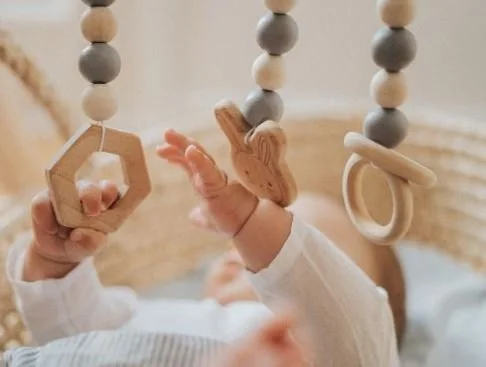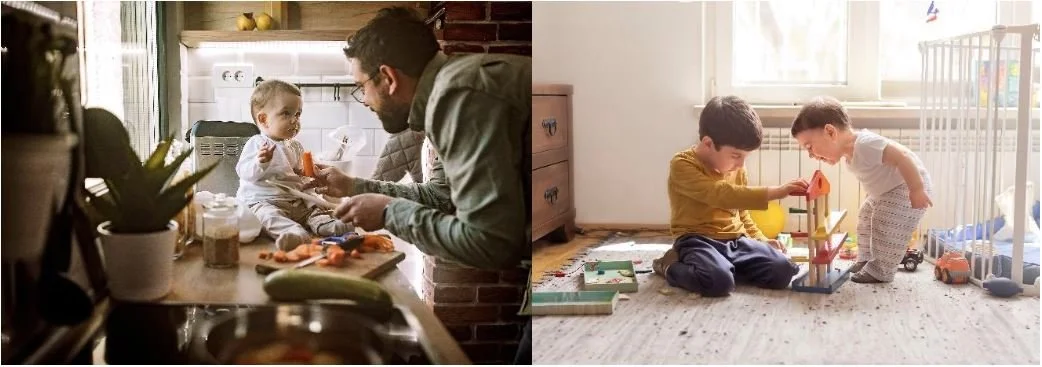How Do Babies Learn About Their Bodies?
Written by Florencia Sandoval Gomez. Edited by Abigail O’ Connell.
As parents, you’ve probably watched your baby wave their arms, kick their legs, and gradually become more coordinated. But how do babies learn where their hands and feet are? How do they develop an understanding of their own bodies? Our research study explores these questions by looking at how infants develop their body schema.
What is body schema?
Body schema is more than a mental map, it’s an active process that helps us move smoothly without having to think about every step. It not only tells us where our limbs are in space but also helps guide and control how we move them (Vignemont et al., 2021). For babies, this system is still developing as they grow and gain new motor skills. Understanding this process can help us learn more about early motor and social development.
The idea of early body awareness goes back to the work of Swiss psychologist Jean Piaget. In his theory of development, he described the ‘sensorimotor stage’, a period in infancy when babies begin to understand their bodies and the world through movement and sensory experiences (Piaget, 1952).
His theory provides a foundation for understanding early body schema development. Building on Piaget’s work, Rochat (1998) found that infants begin exploring their own bodies as early as 2 months old. Through touching and looking at their own hands or feet, babies start forming a basic sense of where their body is in space. This kind of self-exploration is one of the first steps in developing body schema.
What do we know from science?
Modern neuroscience shows that babies start forming "body maps" in the brain very early in life. These maps live in areas involved in movement and touch, such as the sensorimotor cortex (Drew et al., 2018; Marshall et al., 2011). For example, when a baby’s hand is gently touched, their brain shows a specific pattern of electrical activity in regions linked to that body part (Drew et al., 2018). Fascinatingly, this also happens when babies simply watch someone else move. Using a safe and non-invasive method called EEG, researchers found that a particular brain wave, known as the mu rhythm, becomes quieter when babies observe others’ actions (De Klerk et al., 2015). This change in activity is thought to reflect the baby’s brain “mirroring” what they see, almost like it’s practicing the movement internally. Even more remarkably, when babies see someone else's hand or foot being touched, their own brain responds in the same areas as if they were being touched (Meltzoff et al., 2018). These findings highlight the deep connection between brain, body, and social understanding that begins to form even before the baby can speak.
These brain responses aren’t static, and they change as babies grow and learn new motor skills (Marshall & Meltzoff, 2015). This flexibility, also known as neuroplasticity, is a key part of how body schema develops over time. Research also shows that as babies grow and gain more motor experience, their brain regions involved in action processing become more specialised, leading to more efficient and finely tuned responses when observing others’ movements (Chung et al., 2022; Hervé et al., 2022). Even tool use can shape how babies perceive their bodies. As they begin to interact with objects in more complex ways, their brain adapts by updating their internal maps to include these new movements (Vignemont et al., 2021).
Altogether, these findings show that body schema isn’t just about knowing where our limbs are, it’s about building a connection between how we feel, see, and move. And in babies, this connection is being built every day through exploration, imitation, and interaction with others.
What are we studying?
Our study explores this process by measuring babies' brain activity while they watch someone use their hands and feet to press buttons on a toy. We want to find out if babies' brains respond differently when they see hand actions versus foot actions, and how this changes as they get older and develop more motor skills themselves. This can tell us whether babies not only recognise what someone is trying to do (the goal) but also start to pay attention to how they are doing it, helping build their growing body schema.
If you would like to get involved in our study, please click here to sign up!


